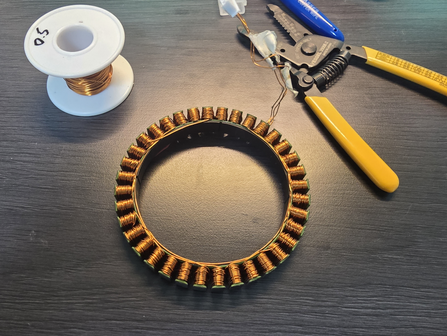Building a robot end to end
- Kim Vijay
- May 20, 2024
- 2 min read
Updated: Feb 5
Actuator Spec.
Quasi-Direct Drive
6:1 reduction ration
BLDC outer stator design
Peak Torque: 7Nm
my focus here was to reduce the cost of the total actuator design, keeping it under $80 and keep the performance the same as the one that cost around $300~1000
Click here to check the BOM.
As a mechanical design engineer, I optimized the material selection by using plastic for both the gears and the casing, significantly reducing costs compared to machining metal components. However, I used off-the-shelf bearings, shafts, and bolts.
The stator generated significant heat due to electromagnetic induction, making it unsuitable for plastic construction. This component was also sourced as an off-the-shelf product.
[240611 Update: Coil Winding Machine]
Initially, I planned to design a coil-winding machine to streamline the process of winding coils onto the stator. However, as the development of this machine faced continuous delays, I ended up winding the coils manually. The image above shows the coil-winding machine I had designed.
Coil Diameter: 0.5 mm
Coil Material: Coated Copper
[240724 Update: ESC, Encoder]
Testing the motor using an ESC and an encoder(AS5600).
[240803 Update: Motor Driver Test]
Motor Driver (B-G431B-ESC1) Test with Actuator
[240811 Update: Peak Torque Test]

Voltage: 24V
peak torque: 7Nm
[240815 Update: New Case Design]

Thinner Case Design -> Reduced the thickness of the electronics section
[240820 Update: Humanoid Body Design]

[240830 Update: Task Learning]
Utilizing Isaac Lab for Reinforcement Learning
(Manager-based RL Workflow Implementation)

Set up the environment, run various examples, and modify them to learn through hands-on experience.
[Led Isaac Sim Study in AI Robotics Korea Group]
I attempted the desired training using Dex-PBT, specifically teaching the Franka robot to throw objects into a box. I am currently learning how to optimize parameter settings to help the robot effectively master the task.
[250205 Update: Motor Tester for better Sim2Real]

Building Motor Tester for....
Plotting RPM-Torque Map (Torque Constant of Custom Actuators)
Finding Lost Motion (Backlash, Torsional Rigidity)
Efficienc
with a precision of 0.5 arc min and Max torque 100Nm

















